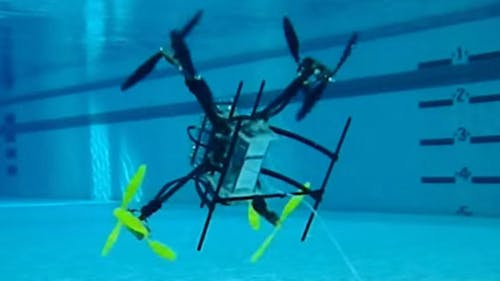Rutgers professor creates drone capable of both flight and aquatics

Rutgers Professor Francisco Javier Diez is soaring to new heights after the launch of his latest project — the Naviator submersible drone.
The Naviator is the first unmanned aerial-underwater vehicle of its kind and can transition from water to air seamlessly.
Diez, a renowned professor in the Department of Mechanical and Aerospace Engineering, has been crafting this invention for nearly five years. The Naviator project was first conceptualized in the Fall of 2012.
Diez said the first tests were finally conducted a year later before the final concept was released. Research is one of the most important phases currently being funded by the Office of Naval Research.
The inception of the Naviator drone is exciting news for many within the scientific community. The drone has essentially invented a new vehicular platform. Diez said there are many vehicles that fly and others that swim — but now, it is possible to both fly and swim with a single drone.
In recent years, there have been many attempts to make such a drone across the globe by groups other than the team at Rutgers. Those researchers may have made some progress, but Diez believes the Naviator is the first of its kind.
The drone represents a technological leap forward in the area of exploratory vehicles as it can be rapidly deployed in the air, travel to a destination and transition underwater. Once submerged, the drone can be used for search and rescue, bridge inspections, ship and port inspections and oil and gas operations in the sea.
“The original idea of an air and water vehicle started as a student senior project,” Diez said. “We added a buoyancy system to a waterproofed drone to transition from water to air. It didn't work very well but it made us realize that the hardest part, which was the water/air transition, was possible and we learned a lot from that experience. Later on, we switch to a multiplane/multirotor transition system that solved the problem.”
The air and sea drone was apparently inspired by the elaborate aerial-underwater vehicles present throughout many popular movies. The idea of the Naviator was to push the boundaries of fiction, Diez said. This meant creating working versions of intricate machines previously confined to the restraints of Hollywood props.
“The concept of a vehicle that can fly in the air and swim underwater appears in novels from Jules Verne to movies from ‘G.I. Joe: The Rise of Cobra’ to ‘Voyage to the Bottom of the Sea,'” Diez said. “Yet, making it a reality has remained elusive since the 1930s when the Germans first tried. What a better challenge than work on something that people thought was not possible.”
Diez discussed the role students at Rutgers played in the process of developing the Naviator: while the entire project may have originated from the idea of one student, there are now around a dozen or so students working on it at any given time.
“My Ph.D student, Marco Maia, has been instrumental from the very beginning on this project,” Diez said. “At the end of the day, it wouldn't have been possible without his help.”
His team’s initial goal was to solve the water to air transition for a drone. Diez said this is the hardest part. Without a good transition, there would be no interest in this type of hybrid vehicle. They started tackling the issue by creating a buoyancy system.
“Buoyancy works great if you are a submarine trying to come from underwater to the surface, but it does nothing to help you transition to air,” Diez said. “We learn this early on. We also realized that we needed a propulsion system that would work both in air and underwater.”
Ultimately, the solution ended up being both simple and elegant. Diez described the Naviator in detail, stating that there were two propellers, one above each other. During the transition, one propeller will be above the water while the other remains underwater. One will be pushing up from underwater and simultaneously the other propeller will be pulling up in the air.
This way, there is maximum thrust during the transition from sea to air. The solution makes the invention consistently reliable and also very robust. As a result of the system’s astounding success, other universities have noticed while some have begun to follow suit.
One of the things Diez said he learned through the development of the Naviator drone is to never believe that something is impossible. He believes that if someone thinks outside the box, dedicates themselves, and trusts their results, eventually they can make things happen. The Naviator is a prime example of what hard work can achieve.
Celebrating his successes with the Naviator, Diez looks to the future. He says that his next goal is to combine many aspects of the drone with artificial intelligence.
“We are working on applying artificial intelligence for navigation in air and underwater, without GPS and also for obstacle avoidance,” Diez said. “At the end of the day, we would like to send the vehicle in a mission without having to rely on a pilot to control the vehicle every step of the way, only for main decisions.”
Daniel Israel is a senior in the School of Arts and Sciences. He is a contributing writer for The Daily Targum.



